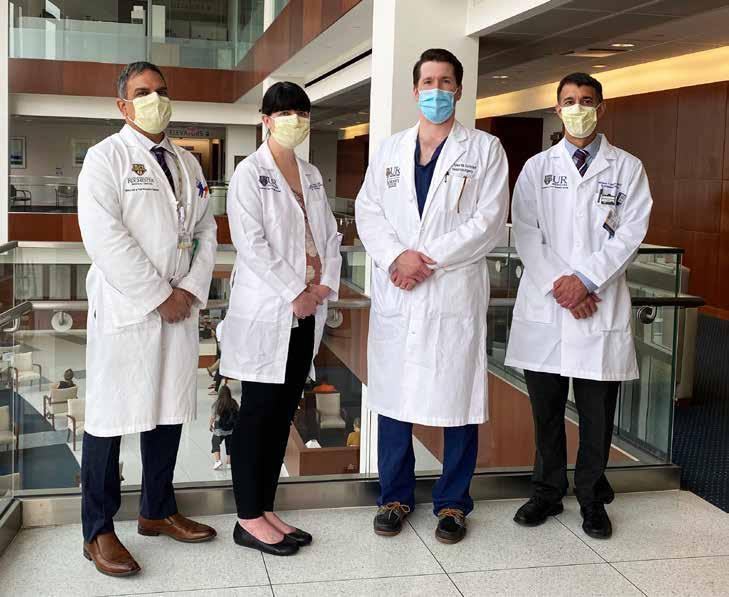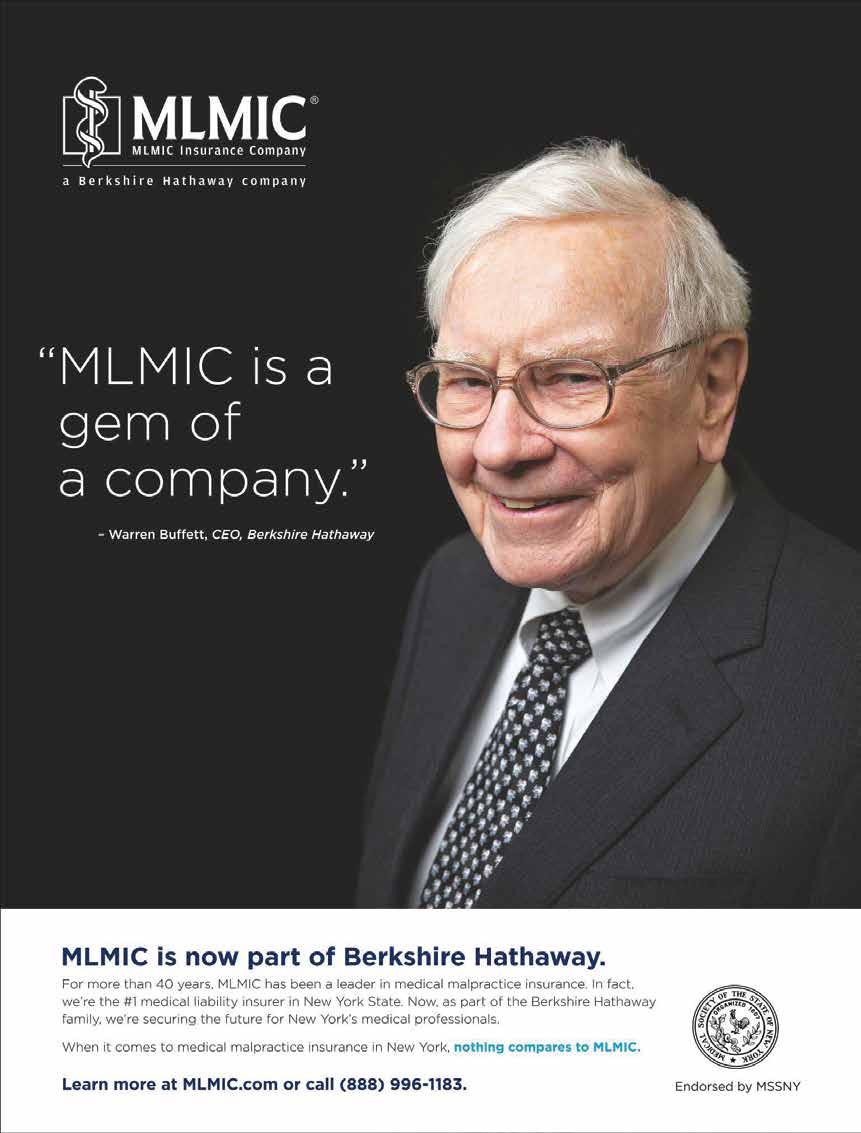
11 minute read
Medical Research
Roswell Park Study: Delaying Antiviral Treatment May Boost Immunity in Stem Cell Transplant Recipients
Closely monitoring virus-specific T-cell responses could allow discontinuation of chronic antiviral medications
Advertisement
• Cytomegalovirus infections reactivate in 25-30% of transplant recipients • Monitoring CMV-specific T cells allows tracking of anti-CMV immune response • Allowing low-level CMV infection could boost subsequent anti-CMV immunity
Patients who develop cytomegalovirus (CMV) infections after allogeneic stem cell transplantation may be able to develop an immunity against the virus, strengthen their immune system and reduce reliance on strong antiviral medications, a team of cellular-therapy specialists from Roswell Park Comprehensive Cancer Center has found. Their findings have been published in a new study in the journal Biology of Blood and Marrow Transplantation. A Roswell Park team led by George Chen, MD, Theresa Hahn, PhD, and Philip McCarthy, MD, studied 315 patients who received hematopoietic stem cell transplants from an allogeneic donor between 2008 and 2015 to determine how many suffered from CMV reactivation and developed anti-CMV immune responses following their transplants. Allogeneic stem cell transplant is a common treatment for many leukemias and other blood cancers. Many patients undergoing allogeneic BMT will experience CMV — a viral infection that can lay dormant in a person’s body for decades but can be reactivated after receiving immunosuppression. CMV reactivation, which can occur in about 25-30% of transplant patients, is associated with few clear symptoms. Unchecked, it can develop into a more serious infection that can damage the lungs, colon, liver or retina.
The research team studied the immune responses of patients to CMV reactivation in the first 365 days after transplantation. They found that those who reactivated CMV and developed three or more CMV-specific T cells per microliter of blood were less likely to subsequently reactivate CMV.
By testing patients for the presence of CMV antigenspecific T cells (CASTs), the authors conclude, medical teams
can determine whether CMV could be controlled by the patient’s immune system alone without medication.
Dr. George Chen
“Some patients are always reactivating CMV because they haven’t developed an immunity and need to continue taking anti-CMV drugs,” says Dr. Chen, an Associate Professor of Oncology in the Department of Medicine at Roswell Park. “At some point, they have to come off the drug. To determine when they can come off, we can measure the number of CMV-specific T cells in the blood to establish whether they have CMV immunity. Once they develop immunity, they have a greater chance of not reactivating the virus again and can come off the drug.”
Dr. McCarthy, Professor of Oncology and Internal Medicine and Director of the Transplant & Cellular Therapy Center at Roswell Park, says this research represents “a completely new look at immunity and immune reconstruction” after cell or organ transplants.
“We all see pathogens in the context of our own tissue antigens,” Dr. McCarthy notes. “When we get a cold, we express viral antigens to T cells, and our T cells recognize that antigen. Everybody has different reactions to a virus.”
Testing for antigen-specific T cells might help protect against other kinds of viral infections for people who receive stem cell or bone marrow transplants, he says.
Dr. Philip McCarthy
While further research in this area is needed before clinical practice is routinely changed, the team’s findings show that it may be beneficial to allow patients, under careful supervision, to develop a low-level viral infection without immediately providing medication. “Low-level antigenemia might be protective, because it may provoke the patient’s immune system to develop anti-CMV immunity,” Dr. McCarthy says. “If the levels remain low and then go away, the patient’s immune system has taken care of the CMV without requiring drug therapy, which can be associated with significant side effects.”
The study was supported by research funding from Immudex and by Roswell Park’s core grant from the National Cancer Institute (project no. P30CA016056).

PhysiciansDOWNLOAD THE RPMD APP FOR
Download our free mobile app — exclusively for physicians and physician offices — for direct access to a complete, up-to-date directory of Roswell Park physicians wherever you go. Email or call to refer a patient or ask a question with a click of a button.
Physician Resource Center Keeping you up-to-date on the rapid evolution of cancer care
As your academic partner in oncology, Roswell Park has created a robust educational platform to keep you abreast of the rapid changes occurring in cancer prevention, treatment and survivorship.
Search RPMD in your app store.

Digital CME now available!
Visit PhysicianResources.RoswellPark.org or scan the QR code to start learning today.
The Stretch is Dead; Long Live the Stretch A Strategy to Preserve the Ability to Pass on Retirement Assets to Your Heirs on Your Timetable, not the Government’s

Joel T. Redmond, CFA, ABV, CFP®, EA Senior Client Experience Manager, SVP
Even before the beginning of this, the most volatile year in public memory – punctuated by a worldwide pandemic, macroeconomic and market convulsions, election uncertainty, and civil unrest – the most cursory look at the government’s financial statements revealed the need for that government to increase its tax receipts. One target for this increase is the approximately $10.8 trillion1 in Individual Retirement Arrangements (IRAs) held across the country. Enter a December 2019 piece of legislation, the Setting Every Community Up for Retirement Enhancement (SECURE) Act, which at one stroke essentially eradicated the stretch provision for non-spousal beneficiaries.
The Problem: The Elimination of the Non-Spousal Stretch
A principal consequence of the SECURE Act is that now, in most cases, the second spouse to die in a married couple is now unable to pass on the IRA assets to his or her child tax-deferred, with the child taking out lifetime distributions based on that same child’s life expectancy (i.e., stretching it out over that life expectancy). Instead, the entire proceeds of the IRA have to be emptied within ten years of the date of death of the original IRA holder. This isn’t a huge deal for those with modest-sized IRAs, but it can be very bad for parents with hefty retirement accounts and kids who are young, irresponsible, or have behavioral or addiction issues. It means that, for a parent leaving her $1MM IRA to her two children ages 20 and 22: • Each child has to spend the entire $500,000 (plus any growth) within ten years of the bequest. • This $500,000 does not have to be paid over a series of equal distributions. It can be distributed all at once, at any time, before the ten years are up. • The children will be taxed at their own ordinary income rates for whatever amount they take out from the IRA each year.
This problem is even worse for those with very large IRAs. If that $1MM IRA becomes $10MM, for the same parent leaving the account to the same two children: • Each child now has to spend $5MM within ten years. • Each child could now distribute $5MM outright, at any time. This could be disastrous for tax purposes. Why? Well, assuming the income is fully taxable and there isn’t any other income, - $5MM at one blow means a federal income tax of $1.81MM.2 - $500,000 at one blow means $145,455, or $1.45MM over ten years at the same rates. This is still quite high, but it is a savings of over $355,000 during this period over a single distribution.3 If, somehow, the stretch could be preserved over a longer period of 20 years, with the annual draw on this same $5MM set at an initial $250,000, the tax burden would only be about $57,955, or $1.16MM – a total savings of over $650,000 over the draw period.4
One Solution: use Charitable Remainder Trusts as Beneficiaries
Let’s look at this last bullet once more and ask the question. If the SECURE Act proscribes distribution periods in excess of ten years for non-spouse beneficiaries, with only a few exceptions,5 how can a non-spouse beneficiary in this example get a 20-year stretch? The answer is simple: bequeath the IRA to a charitable remainder trust for each child, with each child (let’s say the same 20-year-old and 22-year-old) as the noncharitable beneficiaries of the income interest. The economics look like this for each child: • Mom makes a gift to a 20-year charitable remainder trust for the benefit of each child. • Mom dies. • $5MM is paid into each charitable remainder trust. The kids can’t have the money! • Mom’s estate gets a big income tax deduction: almost $1.8MM per trust,6 if each child’s income interest is paid at 5% of the trust’s value each year. • The $10MM is removed from Mom’s estate, so if the proceeds were fully taxable, she’d save $4MM in estate tax (more in states with a state estate tax, such as New York).7 • The kids each get a check in year 1 for $250,000: 5% of $5MM. • This check comes every year for 20 years. • At the end of the 20 years, the remainder (expected to be just over $6MM, at a 6% growth rate) goes to charity.8
Why a 20-year trust, instead of a life trust? The answer is simple: the math doesn’t work. The child needs to be at least 28 years old, using IRS tables, for the present value of the charitable remainder interest to equal 10% of the total gift, which is the minimum bar the IRS sets. If the child is younger, a term of years trust must be used. Each child can be given more than 5% a year, though. In the example above, the charitable interest was larger than the IRS requirement, which stipulates that it be 10% of the total gift, so there’s room for Mom to optimize her
gift to the kids. If we reset the percentage given to each child Joel T. Redmond, CFA, ABV, CFP®, EASenior Client Experience Maneach year so that only this minimum bar is established, we get ager, SVP is a Senior Financial Planner and Vice President at Key Private a scenario that looks like this:9 • Mom’s $5MM gift is now to the same 20-year trust. • The deduction when Mom dies equals no more than 10% of the value of the total $5MM gift, or $500,000. Bank. Joel offers his clients sophisticated financial planning advice and a comprehensive set of strategies to grow and preserve their wealth. A highly experienced professional, he works with individuals, families, corporate executives, business owners and professionals. This is the tax deduction her executor will take on her final return. 1https://www.ici.org/policy/retirement/plan/ira/faqs_iras, accessed 10.8.2020. • The payout percentage has gone way up – from 5% to 2Author’s calculations. Single filer and standard deduction assumed. 3Ibid. 10.916%. Each child will get, at an investment return of 6%, 4Ibid. 5There are five exceptions, actually: spouses, minor children, the disabled, the chronically ill, and individuals not more than 10 years younger than the IRA owner. - $545,133 in year 1 6Author’s calculations. 7Assuming the $5MM is fully taxable at the estate tax rate of 40%. $517,282 in year 2 $490,855 in year 3 8Ibid. 9Ibid. 10Ibid. - And so on, until the final payment in year 20 drops 11With top combined income tax rates at 46% in NYS and top combined estate tax rates at 50%, it should be evident why this is so. to $201,275. • The charity is expected to get $1.75MM at the end of year 20 – more than $4MM less than in the case above. Each child got the difference. 10
Conclusion
These strategies can seem ornate, but they’re really fairly simple. In nontax- Leaders in Progressive Treatment able estates, the charitable donor and heirs will typically end up with slight- of Vascular Disease ly less money when charitable gifts are given. But this is often untrue with those who have taxable estates.11
The stretch IRA was a stroke of genius. It helped manage tax liability to the beneficiary, it helped manage spending, and it gave the donor confidence that the family’s qualified wealth stood a good chance of being preserved for generations to come. Spouses can still use it. And now, with a little philanthropy, nonspousal beneficiaries still can too.
For more on this topic, contact your tax advisor, or enter “Podcast Series: SECURE Act” on www.aicpa.org.
Key Private Bank is part of KeyBank National Association. Opinions, projections or recommendations contained herein are subject to change without notice and are not intended The experts at the Vascular & Endovascular Center of Western New York provide minimally invasive surgical care and superb diagnostic testing as individual investment advice. This utilizing state-of-the-art technology. material is presented for informational purposes only and should not be • Five board-certified vascular surgeons construed as individual tax or finan• Minimally Invasive Vein Care in both Buffalo and Niagara Falls cial advice. KeyBank does not provide legal advice. • • Seamless care coordination with specialty providers Top 3% nationally-ranked vascular surgery practice

Investment products are: NOT FDIC INSURED* NOT BANK GUARANTEED* MAY LOSE VALUE * NOT A DEPOSIT* NOT INSURED BY ANY STATE OR FEDERAL AGENCY ©2020 KeyCorp. KeyBank is Member FDIC. 201007- 884804









